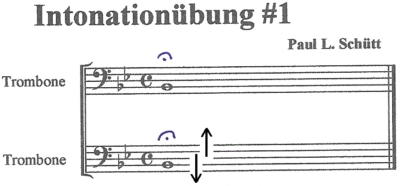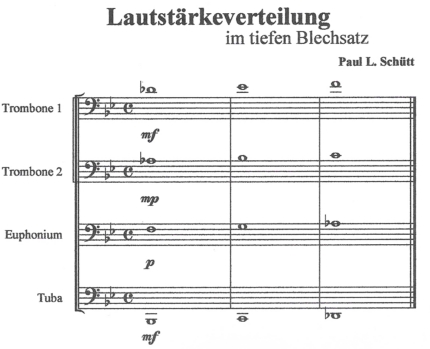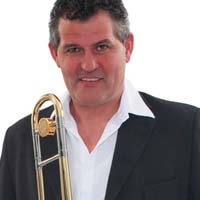The optimum sonic unity of a brassband
As we all know, each building needs a solid foundation. In an orchestra or ensemble, the "low-pitched instruments" act as foundation.
Before that section can hope to become a tight and homogeneous unit, however, each individual player needs to develop their own quality standard and work on it. The aspects to pay attention to in this respect are the musician, the mouthpiece (interface) and the ability to convert one’s energy into notes and ultimately music.
Even short daily practice units have a positive effect on the player’s overall skills, which in turn benefits the entire section and orchestra.

Intonation exercises for low-pitched brass instruments
One important aspect (next to dynamics, phrasing, rests, etc.) is called "intonation", i.e. fine-tuning the pitch.
A brass section with clean intonation is twice as effective as other sections.
Most musicians find playing longtones (sustained notes) boring. Yet, the longtone exercise helps you improve your endurance and can be used to practice melodies at a slow pace. I like to call this slow-mo playing "Tai Chi exercises", because you have ample time to correct what doesn’t sound quite right.
To help musicians develop a sense of which tones are correct or not during a section’s warm-up stage, I like to use an "intentionally wrong" approach to boost the troops’ morale.
For the first exercise, two tuba players (or other musicians) simultaneously play a Bb (or any other note). While the first player keeps his pitch constant, the second tries to slowly raise and lower his pitch. The bigger the pitch difference between the two instrument, the stronger the "beating" becomes. If we now use this exercise for the opposite effect, it helps us develop a feeling what good intonation sounds like and what we need to pay attention to when tuning instruments. Well-balanced parts make playing together easier and more fun.
The mobility of playing and hearing
A second element you need to pay attention to for sections is to maintain the proper hierarchy. All musicians are aware of the loudness conundrum (musical dynamics). For lack of confidence, most musicians’ normal loudness (unfortunately) corresponds to mezzoforte (medium loud).
Playing very softly or loud is much more difficult but can be practiced. In addition, a second voice should never be louder than the lead voice. Then, there is the problem that you don’t always hear yourself, which may be due to the fact that the instruments behind you are playing fortissimo.
Musicians need to be musically "flexible" in order to respond to a changing musical situation, which also means that one needs to train one’s "listening mobility". Often, our part is doubled by other instruments, or other parts end on a note that proves a good starting point for what we are about to play. For these reasons, knowing the pieces and their instrumentation is always a plus, because it helps us focus on the parts we need to pay attention to.

The infamous third voice
Even low-pitched brass instruments have a "first" (or lead) voice. The first trombone (tenor horn) and the tuba (bass trombone) form a framework with often contrapuntal melody lines. The second voice is often centered around the third and needs to be slightly softer than the first voice. The third voice is often the most difficult part, which despite lying in the relatively easy medium register, often has a fill function and therefore plays abstract intervals. The third voice needs to be softer than the first, second and fourth.
Does this mean that one needs to play this voice and (paradoxically) hear it least?
Unfortunately, the answer to this question is "yes", and that shows the problem of this third voice.
Our "inner ear" is in charge of controlling this. What this means is that one needs to think and physically feel the note but only hear it by way of a beautiful harmony or ghastly cacophony. Our brain decides whether it likes or doesn’t like what it hears and perhaps issues instructions to make corrections. I recommend recording section rehearsals, because listening to them afterwards without stress allows us to assess more reliably what we played and what we need to do to improve it.
An instrumental section or orchestra needs time to evolve and grow, and being aware of the factors at play to create a satisfactory sound can be a great help in preparing for section rehearsals.
Have fun and keep enjoying playing music!


